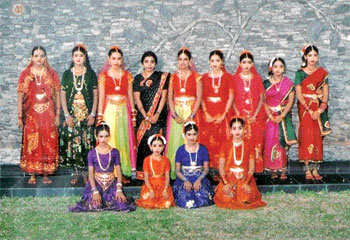Female contribution for dance
Subashini Pathmanathan
In most classical and the folk dances females play the dominant role.
However in some folk and classical dances females and males perform
alike. Oriental classical dance forms such as North Indian classical,
East Indian classical, Kathak, Manipuri, Sri Lankan classical and
Kandyan dance, for instance, give equal position to both males and
females. This is similar in Russian classical ballet, Western, Red
Indian and South East Asian dances.
|

The females did their contributions to dance in different forms |
In the early dance males dominated the scene but now it is otherwise.
This is visible in Indian classical dances such as Odissi and Kuchupidi.
Mohini Aatam is practised only by females, while Kathakali is still
male-dominated.
In almost all Indian classical and folk dances the females perform
the important role in the cultural life of the Indian masses. In any
country culture reveals the pattern of life style, customs and
traditions related to regional practices, religious practices and
historical background.
Earlier practically the females dominated the fields like fine arts,
dance, music, sculptures and paintings. From the very beginning the
female temple dancers and female court dancers enjoyed prestigious
positions in the society. Earlier temple dancers were called Devar
Adiyarkal, Devadasis, Sathirkaaris or Pathiyealalar. In Vaishnava
temples the dancers were called as Sri Vaishnava Manikam.
The females did their contributions to dance in different forms.
Their contributions were mainly depicted in mandapa sculptures, pillar
sculptures and gopura sculptures; even the dancing female figures were
depicted in general architectural sculptures. Similarly even in
paintings, we could see female contribution to dance mainly in temple
walls, roof paintings, pillar paintings, dance hall curtain paintings
and in the stage decoration cut out paintings. Even names and
contribution of female dancers could be seen in several inscriptions.
This could be seen in copper and stone plate inscriptions.
These inscriptions describe the names of numerous female dancers and
their merits, awarded to the female dancers, titles conferred upon them
and details of awards and titles were well defined. Even earlier, as
well as today, in the field of classical and folk dances, the most
attractive and the most outstanding performing artistes have been
females. Even decorations adopted by the female dancers such as hair
dressing and facial makeup are more elaborate than the male
counterparts. The female dancers wear different variety and different
designed costumes.
|

Dancers wear different variety and different designed costumes |
Certain classical items are performed only by female dancers such as
Meenakshi Talaadu, Andal Thirukalyanam and Kurathi. They adopt costumes,
makeup and hairdressing according to the needs of selective dance roles.
The female folk dancers are generally called koothukaris or Koothier
in Tamil and by different names in different states. The colourful
glittering costumes are selected by the females. Simple beautiful makeup
is always adopted by the female folk dancers and the majority of female
dancers wear colourful shawls over heads.
Most dancers perform with decorated sticks or pots, or holding the
decorated shawls in the hands, or holding lamps in the hands. The folk
dances are mainly performed by groups with mixed and variety of
colourful costumes. Some folk dances are only performed by female
dancers, some by females and males together and some by only males. In
both classical and folk dances, beautiful graceful movements, stands,
curving and bending positions could be seen more among female dancers.
Contribution and the role of female dancers in practical dance, as well
as dance research, are much more than that of the male members of the
dance society. |



